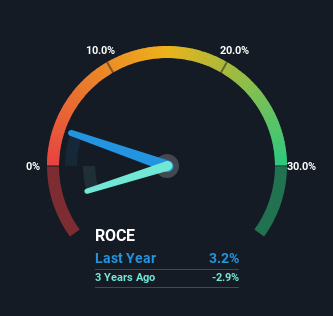Returns On Capital Signal Difficult Times Ahead For LivaNova (NASDAQ:LIVN)
Ignoring the stock price of a company, what are the underlying trends that tell us a business is past the growth phase? More often than not, we'll see a declining return on capital employed (ROCE) and a declining amount of capital employed. Ultimately this means that the company is earning less per dollar invested and on top of that, it's shrinking its base of capital employed. And from a first read, things don't look too good at LivaNova (NASDAQ:LIVN), so let's see why.
Return On Capital Employed (ROCE): What Is It?
For those who don't know, ROCE is a measure of a company's yearly pre-tax profit (its return), relative to the capital employed in the business. To calculate this metric for LivaNova, this is the formula:
Return on Capital Employed = Earnings Before Interest and Tax (EBIT) ÷ (Total Assets - Current Liabilities)
0.032 = US$66m ÷ (US$2.4b - US$335m) (Based on the trailing twelve months to December 2023).
Therefore, LivaNova has an ROCE of 3.2%. In absolute terms, that's a low return and it also under-performs the Medical Equipment industry average of 9.6%.
See our latest analysis for LivaNova
In the above chart we have measured LivaNova's prior ROCE against its prior performance, but the future is arguably more important. If you'd like, you can check out the forecasts from the analysts covering LivaNova for free.
So How Is LivaNova's ROCE Trending?
There is reason to be cautious about LivaNova, given the returns are trending downwards. About five years ago, returns on capital were 4.6%, however they're now substantially lower than that as we saw above. Meanwhile, capital employed in the business has stayed roughly the flat over the period. This combination can be indicative of a mature business that still has areas to deploy capital, but the returns received aren't as high due potentially to new competition or smaller margins. If these trends continue, we wouldn't expect LivaNova to turn into a multi-bagger.
The Bottom Line
In summary, it's unfortunate that LivaNova is generating lower returns from the same amount of capital. It should come as no surprise then that the stock has fallen 47% over the last five years, so it looks like investors are recognizing these changes. With underlying trends that aren't great in these areas, we'd consider looking elsewhere.
If you'd like to know about the risks facing LivaNova, we've discovered 1 warning sign that you should be aware of.
While LivaNova may not currently earn the highest returns, we've compiled a list of companies that currently earn more than 25% return on equity. Check out this free list here.
Have feedback on this article? Concerned about the content? Get in touch with us directly. Alternatively, email editorial-team (at) simplywallst.com.
This article by Simply Wall St is general in nature. We provide commentary based on historical data and analyst forecasts only using an unbiased methodology and our articles are not intended to be financial advice. It does not constitute a recommendation to buy or sell any stock, and does not take account of your objectives, or your financial situation. We aim to bring you long-term focused analysis driven by fundamental data. Note that our analysis may not factor in the latest price-sensitive company announcements or qualitative material. Simply Wall St has no position in any stocks mentioned.

